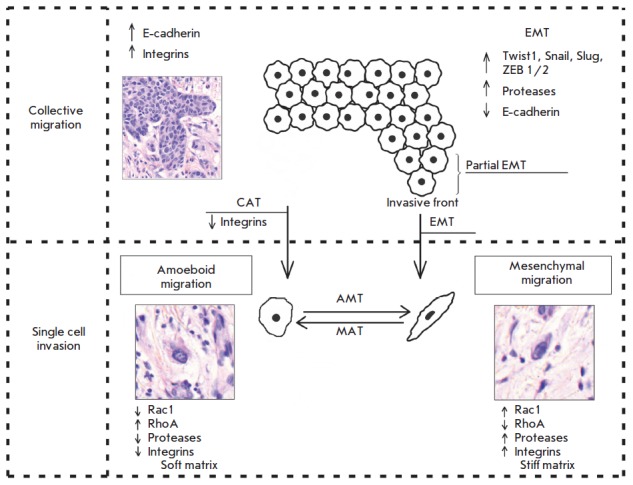Collective–amoeboid Transition on:
[Wikipedia]
[Google]
[Amazon]
 The collective–amoeboid transition (CMT) is a process by which collective multicellular groups dissociate into
The collective–amoeboid transition (CMT) is a process by which collective multicellular groups dissociate into
 The collective–amoeboid transition (CMT) is a process by which collective multicellular groups dissociate into
The collective–amoeboid transition (CMT) is a process by which collective multicellular groups dissociate into amoeboid
An amoeba (; less commonly spelled ameba or amœba; : amoebas (less commonly, amebas) or amoebae (amebae) ), often called an amoeboid, is a type of cell or unicellular organism with the ability to alter its shape, primarily by extending and r ...
single cells following the down-regulation of integrin
Integrins are transmembrane receptors that help cell–cell and cell–extracellular matrix (ECM) adhesion. Upon ligand binding, integrins activate signal transduction pathways that mediate cellular signals such as regulation of the cell cycle, o ...
s. CMTs contrast with epithelial–mesenchymal transition
The epithelial–mesenchymal transition (EMT) is a process by which epithelial cells lose their cell polarity and cell–cell adhesion, and gain migratory and invasive properties to become mesenchymal stem cells; these are multipotent stromal ...
s (EMT) which occur following a loss of E-cadherin
Cadherin-1 or Epithelial cadherin (E-cadherin), is a protein that in humans is encoded by the ''CDH1'' gene (not to be confused with the APC/C activator protein CDH1). Mutations are correlated with Hereditary diffuse gastric cancer, gastric, Here ...
. Like EMTs, CATs are involved in the invasion of tumor cells
A neoplasm () is a type of abnormal and excessive growth of tissue. The process that occurs to form or produce a neoplasm is called neoplasia. The growth of a neoplasm is uncoordinated with that of the normal surrounding tissue, and persists ...
into surrounding tissues, with amoeboid movement more likely to occur in soft extracellular matrix
In biology, the extracellular matrix (ECM), also called intercellular matrix (ICM), is a network consisting of extracellular macromolecules and minerals, such as collagen, enzymes, glycoproteins and hydroxyapatite that provide structural and bio ...
(ECM) and mesenchymal movement in stiff ECM. Although once differentiated, cells typically do not change their migration mode, EMTs and CMTs are highly plastic with cells capable of interconverting between them depending on intracelluar regulatory signals and the surrounding ECM.
CATs are the least common transition type in invading tumor cells, although they are noted in melanoma
Melanoma is the most dangerous type of skin cancer; it develops from the melanin-producing cells known as melanocytes. It typically occurs in the skin, but may rarely occur in the mouth, intestines, or eye (uveal melanoma). In very rare case ...
explant
In biology, explant culture is a technique to organotypically culture cells from a piece or pieces of tissue or organ removed from a plant or animal. The term ''explant'' can be applied to samples obtained from any part of the organism. The extract ...
s.
See also
*Collective cell migration Collective cell migration describes the movements of group of cells and the emergence of collective behavior from cell-environment interactions and cell-cell communication. Collective cell migration is an essential process in the lives of multicellu ...
* Dedifferentiation
Dedifferentiation (pronounced dē-ˌdi-fə-ˌren-chē-ˈā-shən) is a transient process by which cells become less specialized and return to an earlier cell state within the same lineage. This suggests an increase in cell potency, meaning that, f ...
* Invasion (cancer)
Invasion is the process by which cancer cells directly extend and penetrate into neighboring tissues in cancer. It is generally distinguished from metastasis, which is the spread of cancer cells through the circulatory system or the lymphatic sy ...
References
{{reflist Animal developmental biology Cancer research Cell movement Cellular processes Tissue engineering